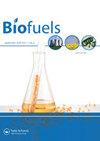A review of microalgal cell wall composition and degradation to enhance the recovery of biomolecules for biofuel production
IF 2.6
4区 工程技术
Q3 ENERGY & FUELS
引用次数: 1
Abstract
Abstract Microalgal biomass has received much attention as a renewable energy source and a possible replacement for petroleum-based fuels. Currently, mechanical, thermal, and chemical cell disruption methods are limited in terms of economics, sustainability, and environmental friendliness. Because of this, biological methods are preferred. The structure and composition of cell walls in commonly used commercial microalgae, as well as the production of lipid and carbohydrate biomolecules for microalgal biofuel, are discussed in this paper. Furthermore, the advantages and disadvantages of various mechanical and non-mechanical cell disruption methods for recovering biomolecules from microalgae are compared. The current biological methods of cell disruption are investigated, such as gene manipulation and autolysis. The relationship between autolysis and programmed cell death and factors influencing the process are also discussed. This review will help researchers select the proper method for recovering biomolecules from microalgae. The findings should expand the use of autolytic biological approaches for economic cell disruption in biofuel commercialisation.微藻细胞壁组成及降解研究进展:提高生物分子的回收,用于生物燃料生产
微藻生物质作为一种可再生能源和可能的石油基燃料替代品而受到广泛关注。目前,机械、热和化学破坏细胞的方法在经济、可持续性和环境友好性方面受到限制。正因为如此,生物方法是首选。本文讨论了常用的商业微藻细胞壁的结构和组成,以及用于微藻生物燃料的脂质和碳水化合物生物分子的生产。此外,还比较了各种机械和非机械细胞破坏方法从微藻中回收生物分子的优缺点。目前的细胞破坏的生物学方法进行了研究,如基因操作和自溶。并讨论了自溶与细胞程序性死亡的关系及影响这一过程的因素。本文综述将有助于研究人员选择从微藻中回收生物分子的合适方法。这一发现将扩大自溶生物学方法在生物燃料商业化中对经济细胞破坏的应用。
本文章由计算机程序翻译,如有差异,请以英文原文为准。
求助全文
约1分钟内获得全文
求助全文
来源期刊

Biofuels-Uk
Energy-Renewable Energy, Sustainability and the Environment
CiteScore
5.40
自引率
9.50%
发文量
56
期刊介绍:
Current energy systems need a vast transformation to meet the key demands of the 21st century: reduced environmental impact, economic viability and efficiency. An essential part of this energy revolution is bioenergy.
The movement towards widespread implementation of first generation biofuels is still in its infancy, requiring continued evaluation and improvement to be fully realised. Problems with current bioenergy strategies, for example competition over land use for food crops, do not yet have satisfactory solutions. The second generation of biofuels, based around cellulosic ethanol, are now in development and are opening up new possibilities for future energy generation. Recent advances in genetics have pioneered research into designer fuels and sources such as algae have been revealed as untapped bioenergy resources.
As global energy requirements change and grow, it is crucial that all aspects of the bioenergy production process are streamlined and improved, from the design of more efficient biorefineries to research into biohydrogen as an energy carrier. Current energy infrastructures need to be adapted and changed to fulfil the promises of biomass for power generation.
Biofuels provides a forum for all stakeholders in the bioenergy sector, featuring review articles, original research, commentaries, news, research and development spotlights, interviews with key opinion leaders and much more, with a view to establishing an international community of bioenergy communication.
As biofuel research continues at an unprecedented rate, the development of new feedstocks and improvements in bioenergy production processes provide the key to the transformation of biomass into a global energy resource. With the twin threats of climate change and depleted fossil fuel reserves looming, it is vitally important that research communities are mobilized to fully realize the potential of bioenergy.
 求助内容:
求助内容: 应助结果提醒方式:
应助结果提醒方式:


